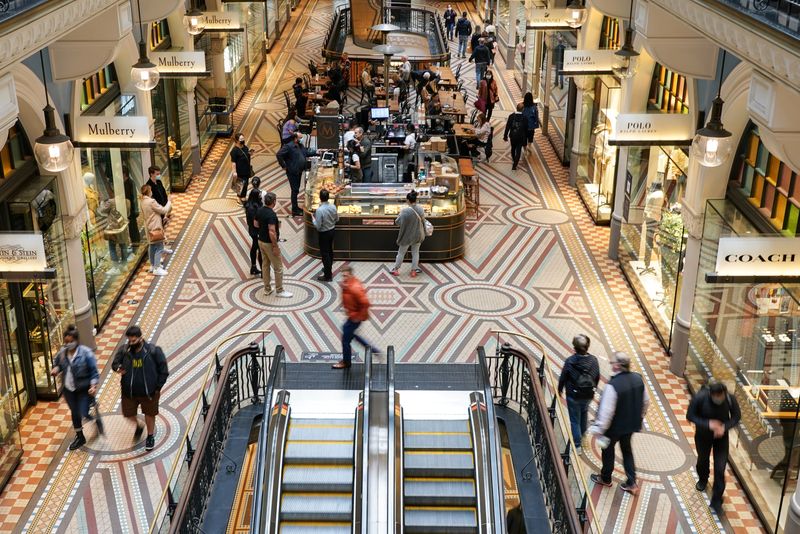Australia retail sales jump in November, inflation resumes climb

FILE PHOTO: People walk through a shopping mall as businesses re-open to vaccinated patrons in the wake of coronavirus disease (COVID-19) regulations easing, following months of lockdown orders to curb the rise in the number of cases, in Sydney, Australia
By Wayne Cole
SYDNEY (Reuters) -Australian shoppers spent big in November as Black Friday sales and online specials spurred demand for clothes, electronics and furniture, a sign consumption was proving resilient to rising interest rates and high inflation.
Data from the Australian Bureau of Statistics (ABS) on Wednesday showed retail sales jumped 1.4% in November from October to a record A$35.9 billion ($24.7 billion).
That was more than twice the median forecast of 0.6%, and October’s result was revised up sharply to a rise of 0.4% from an originally reported drop of 0.2%.
The strength in demand was reflected in separate ABS data on consumer prices which showed annual inflation re-accelerated to 7.3% in November, after a surprise dip to 6.9% in October.
The monthly increase was led by a 4.3% rise in holiday travel and accommodation, a break from the usual pattern of declines in November.
«High jet fuel prices combined with strong consumer demand in November pushed airfare prices up, with accommodation prices also rising,» said Michelle Marquardt, ABS Head of Prices Statistics.
A closely watched measure of core inflation, the trimmed mean, also picked up to its highest since 2018 at an annual 5.6%, showing the broad-based nature of price pressure.
The combination of robust consumption and still rising inflation underline the challenge facing the Reserve Bank of Australia (RBA) as it tries to cool the economy.
In an effort to restrain inflation, the central bank has lifted interest rates by an eye-watering 300 basis points since May to reach a decade-high of 3.1%.
Markets are still wagering the RBA will raise its cash rate by another 25 basis points at its Feb. 7 policy meeting, though futures imply a non-trivial chance it could pause.
Rates are seen peaking by September at between 3.85% and 4.1%.
«The continued strength in inflation coupled with the resilience in consumption will prompt the RBA to keep hiking rates for a while yet,» said Marcel Thieliant, an economist at Capital Economics.
He noted one bright spot in the reports was a slowdown in the cost of new dwellings, which has been a major driver of inflation in the past couple of years.
«That underlines that interest-rate sensitive spending categories are feeling the pinch from the RBA’s aggressive tightening last year,» said Thieliant.
($1 = 1.4512 Australian dollars)


